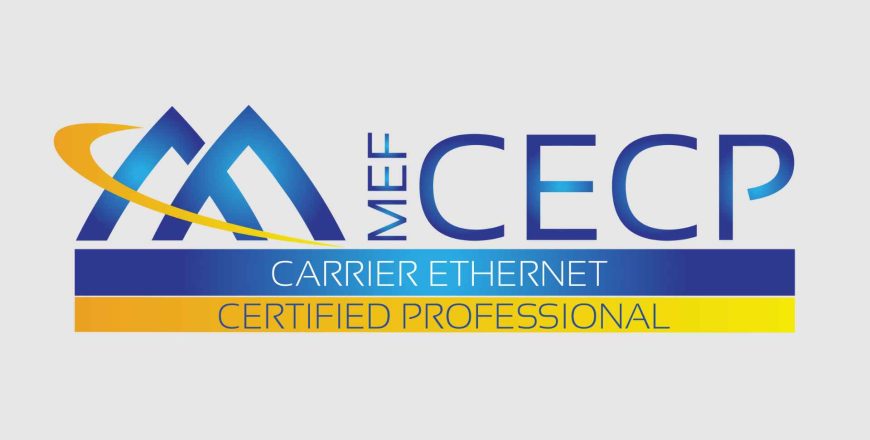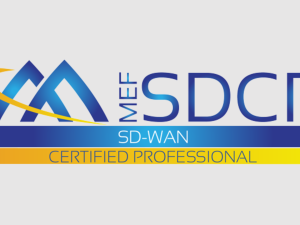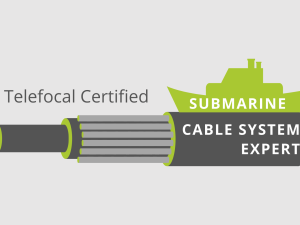MEF Carrier Ethernet Certified Professional (MEF-CECP)

Course Overview
Carriers are in the transitioning phase from the traditional telco era to the modern telco era where data traffic is dominating their networks. A well-known technology to provider cost efficient connectivity over data networks is Ethernet which is the interface of choice for virtually all applications and services. With Ethernet, carriers can deliver these services at lower operating costs, higher flexibility and scalability to all current and future network technologies, always ensuring Quality of Service.
The Metro Ethernet Forum (MEF) has evolved a set of standard service definitions for the kind of Ethernet services customers now require. Service providers can deliver services between sites that appear to customers as end-to-end Ethernet. Network operators can emulate other traditional services (i.e. TDM) over the same infrastructure and deliver all services using Carrier Ethernet.
This training course is intended to provide an in-depth explanation of Carrier Ethernet technologies, the MEF specifications for services, and how these services can be delivered. It includes all the latest enhancements as per CE 3.0 (Blueprint F) standards defined by MEF.
The comprehensive MEF-CECP training by Telefocal Asia will help prepare candidates for the MEF-CECP examination that will be held at the end of the course. Successful candidates who have passed the exam will be certified as a MEF Carrier Ethernet Certifies Professional and recognized in the MEF Certified Professional Registry.
Target Audience
- Product Managers
- Product Planners
- Pre-sales Managers
- Sales Engineers
- Engineers
- Technical Solutions Architect
- Business Solutions Engineers and Managers
- Individuals who design Carrier Ethernet Switching solution for service providers
- Professionals who are interested in deploying Carrier Ethernet service
Duration & Training Format
- Classroom: 5 days
- LIVE Virtual: 35 hours
- A minimum of 8 or more participants is required for a Classroom session to commence.
- A minimum of 6 or more participants is required for a LIVE Virtual session to commence.
- LIVE Virtual courses can be conducted for 5 hours or 7 hours daily. Please note that the number of training days will be extended if you opt for 5 hours daily.
Upcoming Course Dates
19 – 23 May 2025 (Mon – Fri), GMT +8
25 – 29 Aug 2025 (Mon – Fri), GMT +8
If you are keen on attending the above scheduled courses, please register your interest via our course enquiry form.
Course Objectives
At the end of this course, participants will be able to:
- Identify the importance of Carrier Ethernet
- Understand how to build networks to deliver Carrier Ethernet services based on the latest standards
- Design optimal applications of Carrier Ethernet for service provider markets
- Describe Carrier Ethernet deployment solutions
- Describe how Carrier Ethernet is implemented in 4G/5G mobile backhaul networks
- Describe Carrier Ethernet synchronization
- Describe and distinguish between service attributes and understand how these are used to meet customers’ demands
- Compare Ethernet service with other alternatives
- Understand how Carrier Ethernet services may be provided to a remote subscriber who is not served via Carrier Ethernet network
- Examine options for the delivery of next-generation services over Carrier Ethernet
- Identify how Carrier Ethernet service Operation, Administration, and Management (OAM) is being performed
- Identify how Performance Monitoring (PM) and Connectivity Fault Management (CFM) are being performed and measured
Course Outline
- Definitions and Concepts
- Carrier Ethernet Basics
- Subscriber, Service Provider, Network Operator, SP/SO, SLA, and SLS
- External Interfaces, UNI and ENNI
- EVCs and OVCs and their End Points
- Ethernet Addressing and the Basic Operation of an Ethernet Bridge
- Categories of Service Frames: Data, L2CP, and SOAM
- How Service Frames and ENNI Frames can be Marked for Class of Service and Color
- The SLS and the Performance Metrics defined for EVCs and OVCs
- Carrier Ethernet Services
- EVC-based Services (EPL, EVPL, EP-LAN, EVP-LAN, EP-TREE, EVP-TREE)
- OVC-based Services (O-LINE, O-LAN, O-TREE) and their Partitioning into E-Access and E-Transit Services
- Layer 2 Control Protocol (L2CP) Processing and what happens at an L2CP Decision Point
- Design EVC and OVC-based Services to meet Business Objectives
- Design
- Important Service Attributes for OVC-based Services and the Concepts associated with composing EVCs from OVCs
- The Names and Scope of the MEF-defined Maintenance Entities (UNI, ENNI, Operator, Service Provider, EVC, Test, Subscriber)
- Address Operational and Design Problems in EVC and OVC-based Services
- Service Attributes
- Services and Attributes Concepts
- The organization of the Service Attributes for EVC-based Services, and understand, describe, and apply Important Service Attributes for EVC-based Services
- Important Service Attributes for OVC-based Services and the Concepts associated with Composing EVCs from OVCs
- The Capabilities and uses of Synchronous Ethernet and IEEE 1588 (PTP)
- Mobile Backhaul and Synchronization
- How Carrier Ethernet is used in Mobile Backhaul (MBH) Networks
- The 3 Types of Synchronization used in Mobile Backhaul Networks (Frequency, Phase, Time)
- The Capabilities and Uses of Synchronous Ethernet and IEEE 1588 (PTP)
- The Class of Service and Service OAM Requirements defined in the Mobile Backhaul Implementation Agreement
- Bandwidth Profiles
- Class of Service and Traffic Management
- MEF Bandwidth Profile (BWP) Algorithm and the BWP parameters CIR, CBS, CIRMAX, EIR, EBS, EIRMAX, CF and CM including the Structure of Envelopes and Token Sharing
- The Application of Bandwidth Profiles to Ethernet Services for both Ingress and Egress
- Layer 2 Control Protocols (L2CP)
- Services and Attributes
- The categories of Service Frames: Data, L2CP, and SOAM
- The Principles associated with Layer 2 Control Protocol (L2CP) Processing and what happens at an L2CP Decision Point
- Performance Metrics
- Performance Metrics, Class of Service, and Traffic Management
- Performance Tiers and CoS Performance Objectives
- The SLS and the Performance Metrics defined for EVCs and OVCs
- SAT and SAC
- The concept of Service Lifecycle and important phases of the Service Lifecycle: Configuration, Service Activation Testing, Fault and Performance Monitoring
- The major components of a Service Activation Test (SAT) and how they are used
- Class of Service
- Performance Metrics, Class of Service, and Traffic Management
- Class of Service Names and Class of Service Labels
- External Interfaces
- Carrier Ethernet Basics
- External interfaces, UNI and ENNI
- Ethernet Addressing and the Basic Operation of an Ethernet Bridge
- Services and Attributes
- Important Service Attributes for UNIs and ENNIs, including the use of Link Aggregation
- EVCs and OVCs
- Carrier Ethernet Basics
- Subscriber, Service Provider, Network Operator, SP/SO, SLA, and SLS
- Services and Attributes
- Characteristics of the OVC-based Services (O-LINE, O-LAN, O-TREE) and their partitioning into E-Access and E-Transit Services and understand their Purpose and Important Attributes
- Hairpin switching for OVCs
- Service Operations and Management (SOAM)
- Service OAM – Fault Management and Performance Monitoring
- Basic Components of the SOAM Infrastructure
- Maintenance Entity (ME)
- ME Group (MEG)
- ME Endpoint (MEP)
- ME Intermediate Point (MIP)
- MEG Level
- The Messages and Indications of SOAM Fault Management – CCM, LBM/R, and LTM/R, RDI, AIS, LCK, TST
- The Mandatory SOAM Performance Management Solution – PM1 (DMM/R and SLM/R)
- The Optional PM Solutions and how they differ from PM1 (1DM and LMM/R)
Prerequisites
It is preferred for candidates to have a good understanding of IEEE802.1 standards, principles of internetworking, IP, Ethernet, WAN design and concepts.
Certification, Exam Details and Format
At the end of the course, candidates will sit through a proctored MEF-CECP examination.
- The examination will be conducted in English.
- Candidates will need to complete 70 MCQs within 105 minutes.
- The MEF-CECP certificate will only be issued upon scoring 67% or higher in the exam, and will be valid for 3 years from the date of issue.
- Learning domains (topics) covered:
- Services and attributes
- Class of Service and Traffic Management
- Service OAM
- Infrastructure, Operations, and Applications
- Ethernet, MEF Basics, and MEF Certification
- Re-certification should be taken within 3 years of certification, prior to certificate expiration.
Why Choose Telefocal Asia for MEF-CECP Training and Certification?
- We conduct pre-training assessment of participants before course commencement with a goal to bridge knowledge gaps and meet training expectations.
- Our trainers have many years of practical design and deployment experiences with telco operators and vendors alike.
- Our trainers are engaging with excellent presentation and delivery skills.
- We have a solid track record of attaining a high MEF-CECP Certification rate for our course participants.
- Our MEF-CECP training manuals are officially audited by the MEF and professionally prepared, printed and bound.
- Last but not least, our trainers are MEF-CECP certified.


